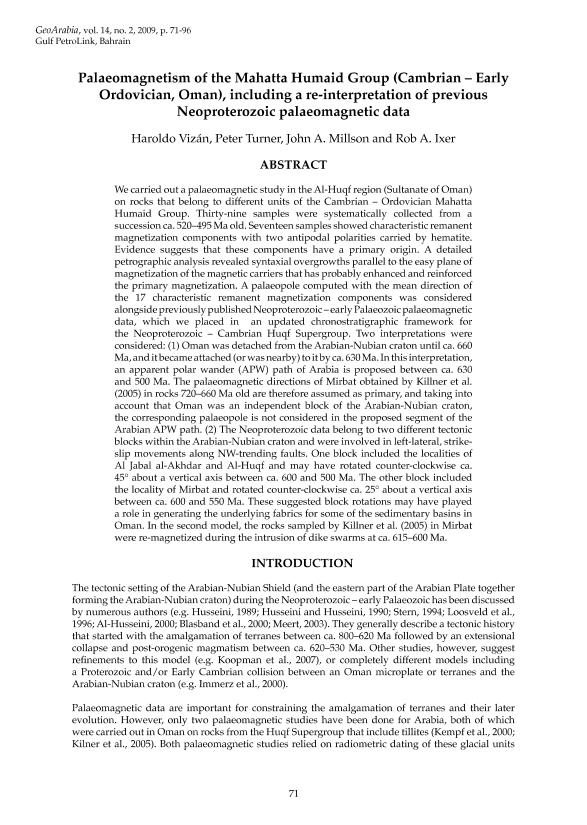Artículo
Palaeomagnetism of the Mahatta Humaid Group (Cambrian – Early Ordovician, Oman), including a re-interpretation of previous Neoproterozoic palaeomagnetic data
Fecha de publicación:
02/2009
Editorial:
GeoScienceWorld
Revista:
Geoarabia
ISSN:
1025-6059
Idioma:
Inglés
Tipo de recurso:
Artículo publicado
Clasificación temática:
Resumen
We carried out a palaeomagnetic study in the Al-Huqf region (Sultanate of Oman) on rocks that belong to different units of the Cambrian – Ordovician Mahatta Humaid Group. Thirty-nine samples were systematically collected from a succession ca. 520–495 Ma old. Seventeen samples showed characteristic remanent magnetization components with two antipodal polarities carried by hematite. Evidence suggests that these components have a primary origin. A detailed petrographic analysis revealed syntaxial overgrowths parallel to the easy plane of magnetization of the magnetic carriers that has probably enhanced and reinforced the primary magnetization. A palaeopole computed with the mean direction of the 17 characteristic remanent magnetization components was considered alongside previously published Neoproterozoic – early Palaeozoic palaeomagnetic data, which we placed in an updated chronostratigraphic framework for the Neoproterozoic – Cambrian Huqf Supergroup. Two interpretations were considered: (1) Oman was detached from the Arabian-Nubian craton until ca. 660 Ma, and it became attached (or was nearby) to it by ca. 630 Ma. In this interpretation, an apparent polar wander (APW) path of Arabia is proposed between ca. 630 and 500 Ma. The palaeomagnetic directions of Mirbat obtained by Killner et al. (2005) in rocks 720–660 Ma old are therefore assumed as primary, and taking into account that Oman was an independent block of the Arabian-Nubian craton, the corresponding palaeopole is not considered in the proposed segment of the Arabian APW path. (2) The Neoproterozoic data belong to two different tectonic blocks within the Arabian-Nubian craton and were involved in left-lateral, strikeslip movements along NW-trending faults. One block included the localities of Al Jabal al-Akhdar and Al-Huqf and may have rotated counter-clockwise ca. 45° about a vertical axis between ca. 600 and 500 Ma. The other block included the locality of Mirbat and rotated counter-clockwise ca. 25° about a vertical axis between ca. 600 and 550 Ma. These suggested block rotations may have played a role in generating the underlying fabrics for some of the sedimentary basins in Oman. In the second model, the rocks sampled by Killner et al. (2005) in Mirbat were re-magnetized during the intrusion of dike swarms at ca. 615–600 Ma.
Palabras clave:
Paleomagnetism
,
Neoproterozoic
,
Cambrian
,
Tectonics
Archivos asociados
Licencia
Identificadores
Colecciones
Articulos(IGEBA)
Articulos de INSTITUTO DE GEOCIENCIAS BASICAS, APLICADAS Y AMBIENTALES DE BS. AS
Articulos de INSTITUTO DE GEOCIENCIAS BASICAS, APLICADAS Y AMBIENTALES DE BS. AS
Citación
Vizan, Haroldo; Turner, Peter; Millson, John; Ixer, Rob; Palaeomagnetism of the Mahatta Humaid Group (Cambrian – Early Ordovician, Oman), including a re-interpretation of previous Neoproterozoic palaeomagnetic data; GeoScienceWorld; Geoarabia; 14; 2; 2-2009; 71-96
Compartir




